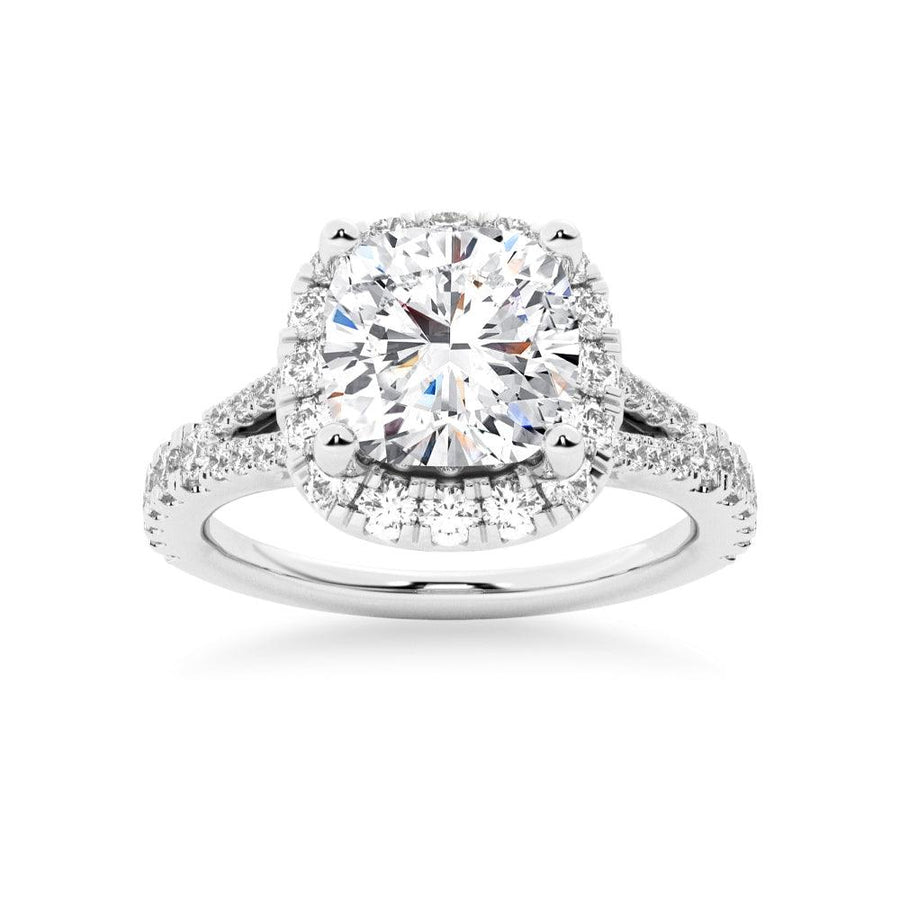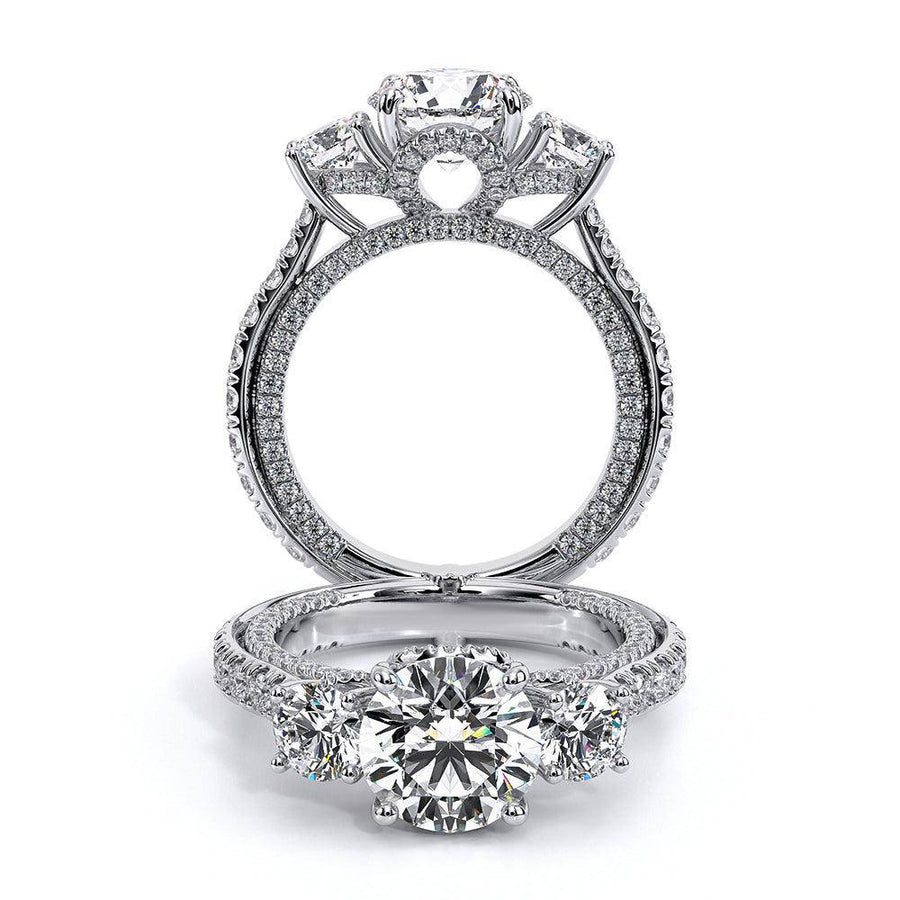Moissanite vs. Diamonds: What’s the Difference?
Diamonds might reign supreme in the world of engagement rings. While the center stone of an engagement ring is often a diamond, there are other options that can make an engagement ring just as beautiful. If you want something different, you have plenty of choices—including stones that look remarkably similar to diamonds, such as Moissanite.
The key differences between moissanite and diamond includes price, durability, brilliance, and color. Let’s compare Diamonds vs Moissanite.
What is Moissanite?
Moissanite is a near-colorless gemstone that’s composed of silicon carbide. First discovered in 1893 by a French scientist named Henri Moissan, who later won the Nobel Prize in Chemistry, moissanite was originally found in the crater left behind by a fallen meteor.
Although they look similar at first glance, moissanite is very different from a diamond. Diamonds are made of carbon, whereas moissanites are made of pure silicon carbide — an extremely rare, naturally-occurring mineral.
The natural moissanite discovered by Moissan in 1893 is exceptionally rare, making it practically impossible to use natural moissanite for jewelry. Natural moissanite is incredibly rare, so moissanite available today is laboratory-created.
Although it’s made to seem like diamonds, moissanite is compositionally and visually quite different from a diamond.
Moissanite vs. Diamonds
| Moissanite | Diamonds |
| More affordable | Far more expensive |
| 9.25-9.5 on the Mohs hardness scale | 10 on the Mohs hardness scale |
| Rainbow-like light reflection | White light reflection |
| Traditionally has a yellow or green tint | Color range varies |
| Lab grown | Natural and lab grown |
Diamond vs. Moissanite: Price
A diamond’s price and value are dependent on its 4 C’s (Cut, Color, Clarity and Carat). These elements work together to form the beauty and brilliance of the stone. Because diamonds are mostly natural rather than lab-grown, they can vary hugely in price, value and quality.
For the same size from the top view, moissanites are dramatically lower in pricing than diamonds of that size. Moissanite gems typically vary in price only based on size and whether the stone is Premium or Super Premium.
The biggest advantage of moissanite over diamonds is the price, for moissanite is considerably cheaper than a diamond. A moissanite gem is approximately one-tenth the cost of a mined diamond of equal size and quality. The value of moissanite is greater with larger carat weights. If you want a large carat, white gemstone, but you don’t have the money for a large diamond, moissanite is the way to go.
Diamond vs. Moissanite: Durability
Gemstones are measured on the Mohs Scale of Hardness, which assesses a gem’s ability to withstand surface scratching. The scale ranges from 1 as the softest to 10 as the hardest.
Diamonds are known for their durability. Diamonds are the hardest known mineral and receive a 10 on the Mohs Scale of Hardness. Because of this exceptional score, diamonds are very durable and ideal for daily wear.
However, moissanite doesn’t fall far behind. Moissanite is the second hardest to diamonds on the Mohs hardness scale. On the Mohs scale of hardness, a moissanite measures in at 9.25-9.5, so they are suitable for daily wear.
The Mohs Scale of Hardness
| Hardness | Substance or mineral |
| 10 | Diamond |
| 9.5–10 | Boron |
| 9.25–9.5 | Moissanite |
| 9 | Tungsten carbide |
| 8.5 | Chromium |
| 8 | Cubic zirconia |
| 7.5–8 | Emerald |
| 7 | Quartz |
| 6–7 | Silicon |
| 6 | Titanium |
| 5.5 | Glass |
| 5 | Apatite (tooth enamel) |
| 4–4.5 | Steel |
| 4 | Iron |
| 3.5 | Platinum |
| 3 | Copper |
| 2.5–3 | Gold |
| 2–2.5 | Halite (rock salt) |
| 2 | Calcium |
| 1.5 | Lead |
| 1 | Talc |
Diamond vs. Moissanite: Brilliance and Fire
When you’re looking at a diamond, you’ll notice both brilliance (which refers to the gemstone's ability to reflect white light) and fire (which refers to the gemstone's ability to reflect colored flashes). Moissanite also shows both, in general, moissanite has more brilliance than a diamond. It has more fire and brilliance than any other gemstone, because moissanite is double refractive, it is cut differently than diamonds to enhance the sparkle.
Diamond vs. Moissanite: Color
Both moissanite and diamonds can both be colorless or have some color to them. A colorless diamond, whether natural or lab created, has a natural body color that contains no traces of yellow, brown, or grey, resulting in a dazzling, bright white appearance. Diamonds are graded on a GIA Color scale from D to Z. The GIA D-Z scale is divided into five categories:
- Colorless — D, E, F.
- Near Colorless — G, H, I, J.
- Faint — K, L, M.
- Very Light — N, O, P, Q, R.
- Light — S, T, U, V, W, X, Y, Z.
Moissanite is also available in colors equivalent to “Near Colorless” G to I range and “Colorless” D through F range. This gives moissanite buyers great options for mimicking their favorite diamond looks and styles. All Moissanites and Moissanite engagement rings of MSBLUE Jewelry, which are the highest quality stones available on the market today. They are guaranteed to be DEF in color and VS2 clarity or better.
Our Best Selling Engagement Rings
At MSBLUE, we strive to provide a superior alternative to diamonds. In our pursuit of excellence, these moissanite engagement rings are our most popular conflict-free and environmentally friendly choices.
Solitaire engagement rings are a timeless classic. Handcrafted moissanite solitaire engagement rings from MSBLUE are offered in a variety of settings, and shapes, to make this classic look unique.

3 CT. Six-Prong Solitaire Moissanite Engagement Ring With Hidden Halo
Price From: $159
Halo diamond rings highlight the center gemstone by surrounding it with diamonds, often making the center gem appear larger. We have unique halo rings. Explore our halo engagement rings at MSBLUE.

2NEW Cushion Cut Split-Shank Moissanite Halo Engagement Ring
Price From: $209
Three Stone rings feature two side diamonds that accentuate the size and brilliance of the center diamond. The three-stone engagement ring represents friendship, love, and fidelity, or past, present, and future.
Browse our stunning three stone engagement rings at MSBLUE.

Tapered Baguette Moissanite Three Stone Engagement Ring
[Limit 1 Per Purchase] $239.00 Price: $99
Side-stone engagement rings feature side diamonds, which bring out the brilliance of the center stone. Shop a variety of styles of engagement rings with side stones at MSBLUE.

4.76 CTW. Unique Three Stone Princess-Cut Moissanite Ring In Sterling Silver
Price From: $299
A timeless, exquisite assortment of handcrafted masterpieces that capture the romance and elegance of a bygone era. Each ring in this collection is a testament to the enduring allure of vintage design, meticulously crafted to celebrate the love stories of the past while creating new ones for the future. Explore more band engagement rings at MSBLUE.

Silver Halo Princess Cut Moissanite RinVintage Two-Tone Three Stone Round Moissanite Engagement Ring
Price From: $559.00
General Benefits of Moissanite
| Conflict-Free | Moissanite is lab created with minimal environmental impact. |
| Value | Moissanite is less expensive per carat than many other gemstones. Approximately one-tenth the cost of a mined diamond of equal size and quality. |
| Quality | Thanks to the meticulous environment that lab-grown moissanite jewels are produced in, if a gemstone isn’t the perfect clarity or has any form of obvious inclusions or blemishes, it won’t be up for sale. |
| Brilliance | Due to this jewel’s High Refractive Index, it can create a superior sparkle, unmatched by a standard diamond. It has more fire and brilliance than any other gemstone. |
| Durability | Moissanite gemstones are a 9.25 on the Mohs Scale of Hardness, so they are suitable for everyday wear. |
| Timeless Appearance | For those looking for alternatives to a diamond, some may turn to cubic zirconia. However, unlike cubic zirconia, moissanite doesn’t develop a cloudy appearance over time. In fact, a moissanite jewel will maintain a cleaner look over a diamond. Dirt and oils will reduce the luster of a diamond faster than moissanite. |










Leave a comment